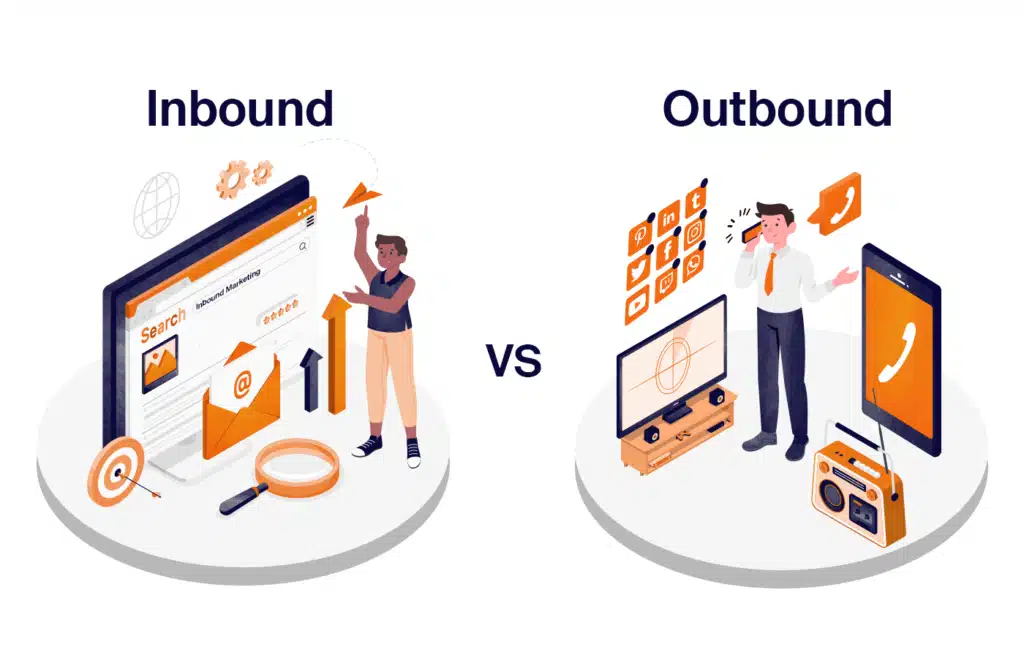Telemarketing has long been a corporate staple, serving as a direct avenue for organizations to engage with their target audience. However, not all telemarketing campaigns are equal. In general, there are two types: Inbound and Outbound Telemarketing. Though they are both classified as telemarketing, their tactics, goals, and outcomes might vary substantially. In this blog post, we’ll go over the key differences between each to help organizations make the most of their telemarketing efforts.

Definition: Inbound and Outbound Telemarketing
Inbound Telemarketing
This is the process by which potential customers or present clients call a firm on their own initiative. This could be in response to an advertisement they saw, to place an order, or to inquire about a product or service.
Outbound Telemarketing
The corporation starts the call with prospective or present clients in this technique. This could be for sales, surveys, appointment scheduling, or other company goals.
Intent: Inbound and Outbound Telemarketing
Inbound
The primary goal is to answer questions, provide information, and assist callers. Because the potential consumers called, they most likely had a clear goal in mind.
Outbound
Companies use this strategy to contact potential clients in order to notify them about a new product, obtain feedback, or make a sale.
Training Required: Inbound and Outbound Telemarketing
Inbound
Agents frequently require intensive product knowledge training since they must be prepared to answer a variety of questions. They must also be knowledgeable in customer service and capable of handling high phone volumes.
Outbound
Agents may need training in sales techniques, persuasion, and managing rejections in addition to their product knowledge.
Metrics for Success: Inbound and Outbound Telemarketing
Inbound:
Success is frequently defined by the number of queries resolved, customer satisfaction rates, average hold times, and first-call resolution.
Outbound:
Metrics could include the number of successful sales, scheduled appointments, or surveys completed. Conversion rates and average call times can also be relevant.
Customer Perception: Inbound and Outbound Telemarketing
Inbound
Customers who initiate these calls are typically more receptive. Because the emphasis is on service, the encounter is usually evaluated favorably if their complaints are addressed quickly.
Outbound
This can be considered intrusive, especially if the call is uninvited. However, with the correct technique and targeting, it can still be an effective way to interact with clients.
Tools and Technology: Inbound and Outbound Telemarketing
Inbound
It is frequently necessary to use technologies such as Interactive Voice Response (IVR) to successfully route calls, as well as sophisticated Customer Relationship Management (CRM) solutions to swiftly access customer data.
Outbound
Use predictive dialers to reduce the number of calls made, as well as scripts for direct talks.
Costs: Inbound and Outbound Telemarketing
Inbound
Costs are often associated with maintaining a call center infrastructure, training staff, and marketing activities that drive calls to the center.
Outbound
Call lists (unless organic), CRM systems, and the training and resources required to make sales or acquire data can all be considered expenses.
Regulatory Considerations
Inbound
Because callers initiate the contact, compliance is usually easier. Businesses must, however, continue to follow data protection rules.
Outbound
From a regulatory standpoint, this can be more difficult. Many nations have strong restrictions on unsolicited calls, so firms must be aware of do-not-call registries and other similar services.
Must Read: Insurance Back Office Support Tasks You Need To Outsource In 2023
Future Trends
Inbound
With the emergence of AI and chatbots, many simple inquiries may now be answered without the need for human participation. As a result, the emphasis of inbound telemarketing may shift toward more nuanced, value-driven engagements.
Outbound
The key word here is customization. Companies may make their outreach more focused with improved data analytics, boosting their chances of success.
Primary Challenges:
Inbound
Handling high call volumes, particularly during peak hours, and ensuring that customer problems are answered quickly and effectively.
Outbound
Overcoming the stigma of cold calling and ensuring that calls are appropriate and timely for the recipient
Conclusion:
While both inbound and outbound telemarketing have unique characteristics, obstacles, and rewards, the end aim is the same: to develop a favorable relationship between businesses and their customers. Companies may modify their strategy for optimal impact by understanding the subtleties of each method. Telemarketing is a significant tool in the modern corporate landscape, whether it’s answering consumer queries or reaching out with a new offer
